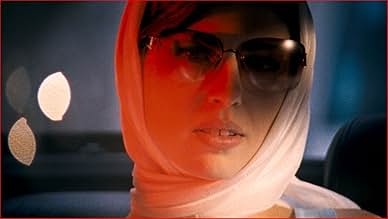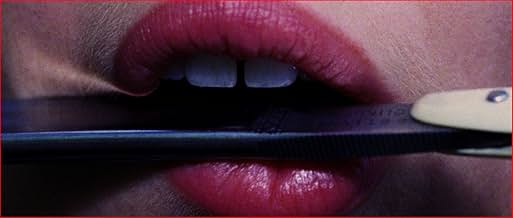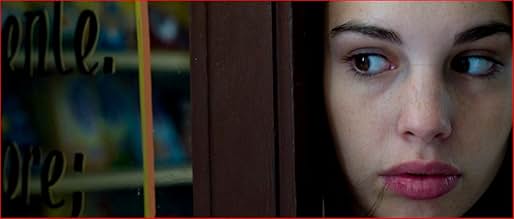CALIFICACIÓN DE IMDb
6.1/10
6.8 k
TU CALIFICACIÓN
De pequeña, Ana era una niña rebelde. Se sentía atormentada por imágenes de la muerte y una figura sombría y siniestra vestida de negro. Ahora, de adulta, vuelve a verse atormentada por form... Leer todoDe pequeña, Ana era una niña rebelde. Se sentía atormentada por imágenes de la muerte y una figura sombría y siniestra vestida de negro. Ahora, de adulta, vuelve a verse atormentada por formas oscuras y de otro mundo.De pequeña, Ana era una niña rebelde. Se sentía atormentada por imágenes de la muerte y una figura sombría y siniestra vestida de negro. Ahora, de adulta, vuelve a verse atormentada por formas oscuras y de otro mundo.
- Dirección
- Guionistas
- Elenco
- Premios
- 7 premios ganados y 6 nominaciones en total
Charlotte Eugène Guibeaud
- Ana adolescente
- (as Charlotte Eugène Guibbaud)
Biancamaria D'Amato
- La mère
- (as Bianca Maria D'Amato)
- Dirección
- Guionistas
- Todo el elenco y el equipo
- Producción, taquilla y más en IMDbPro
Opiniones destacadas
Act 1 is brilliant - a terrifying, sensual, nightmarish homage to Dario Argento. Act 2 is boring filler. Act 3 has a nasty torture scene and is better than the second act, but still feels pointless.
The NY TIMES called AMER "an exercise in giallo (eroticized horror), a richly colorful mosaic of sinister sidelong glances" while the LA TIMES enthused, "a nightmare vision of desire and fear -gorgeous, heady, dazzling!" but these pointed paeans are only partly true. Except for the odd snippet, there's no dialog or musical score in the three vignettes depicting the life of a disturbed young woman (childhood, adolescence, adulthood) and although the last sequence contains elements of the giallo, the film is more of an homage to the indelible images of "maestro of the macabre" Mario Bava.
AMER's first segment on a child's reaction to her grandfather's death re-imagines the opening tale in Bava's trilogy I TRE VOLTE DELLA PAURA (aka BLACK SABBATH) from prying a valuable object out of a dead man's hand and the nightmare that follows right down to the dripping water and eerie blue, green, and red light that bathed the terrifying tableaux. The second segment on the girl's dangerous sexual awakening combines Bava's OPERAZIONE PAURA (aka KILL BABY KILL) and it's white soccer ball with the nebulous evil-under-the-sun aura of Tennesse Williams' SUDDENLY LAST SUMMER. The third and final scene that sees the young woman revisiting the abandoned villa where she grew up actually does reference BLOOD & BLACK LACE-style gialli with its black gloves, straight razor, and stalking sequence that leads up to a graphic murder. Unfortunately, there's only one (barely set piece) slaying in AMER and this dreamy collage of jump cuts, split screens, and undeniably beautiful imagery is less than the sum of its parts which may prove disappointing to hard-core horror fans. Cineastes -and those who enjoy avant-garde narrative as well as color-drenched kaleidoscopic visuals- should, however, get their money's worth. Hélène Cattet & Bruno Forzani's offbeat endeavor also reeks of Roman Polanski's REPULSION and I found the "eroticized" exercise admirable but more dull than anything else.
AMER's first segment on a child's reaction to her grandfather's death re-imagines the opening tale in Bava's trilogy I TRE VOLTE DELLA PAURA (aka BLACK SABBATH) from prying a valuable object out of a dead man's hand and the nightmare that follows right down to the dripping water and eerie blue, green, and red light that bathed the terrifying tableaux. The second segment on the girl's dangerous sexual awakening combines Bava's OPERAZIONE PAURA (aka KILL BABY KILL) and it's white soccer ball with the nebulous evil-under-the-sun aura of Tennesse Williams' SUDDENLY LAST SUMMER. The third and final scene that sees the young woman revisiting the abandoned villa where she grew up actually does reference BLOOD & BLACK LACE-style gialli with its black gloves, straight razor, and stalking sequence that leads up to a graphic murder. Unfortunately, there's only one (barely set piece) slaying in AMER and this dreamy collage of jump cuts, split screens, and undeniably beautiful imagery is less than the sum of its parts which may prove disappointing to hard-core horror fans. Cineastes -and those who enjoy avant-garde narrative as well as color-drenched kaleidoscopic visuals- should, however, get their money's worth. Hélène Cattet & Bruno Forzani's offbeat endeavor also reeks of Roman Polanski's REPULSION and I found the "eroticized" exercise admirable but more dull than anything else.
Yeah, I'm really not a fan of these 'style over substance' style movies. I saw this film's follow-up, THE STRANGE COLOUR OF YOUR BODY'S TEARS, before I saw this, so I had some idea of what to expect, but still this film's almost entire lack of storyline and coherent narrative was enough to finish me off. I get what the filmmakers are doing, and I'm a huge fan of the giallo genre, but this just smacks of pretentiousness and comes across as completely pointless.
AMER tells the visual story of a girl whose life is chronicled in various parts. She's subjected to a terrifying experience as a child, and then her perfect life as an adult is brought into jeopardy by the intervention of a mysterious stranger. There's no more to it than that; this is an entirely visual production, with thousands of cuts and edits designed to make the most beautiful experience ever.
The images are great, and the soundtrack is hugely evocative, but the whole thing lacks so much substance that it's a real chore to sit through and it seems to go on forever and ever. This is from a guy who's been enjoying the art films of the likes of Werner Herzog and Kim Ki-duk. But AMER is a case of the 'Emperor's new clothes'; the lights are on, and they're very pretty, but nobody's home.
AMER tells the visual story of a girl whose life is chronicled in various parts. She's subjected to a terrifying experience as a child, and then her perfect life as an adult is brought into jeopardy by the intervention of a mysterious stranger. There's no more to it than that; this is an entirely visual production, with thousands of cuts and edits designed to make the most beautiful experience ever.
The images are great, and the soundtrack is hugely evocative, but the whole thing lacks so much substance that it's a real chore to sit through and it seems to go on forever and ever. This is from a guy who's been enjoying the art films of the likes of Werner Herzog and Kim Ki-duk. But AMER is a case of the 'Emperor's new clothes'; the lights are on, and they're very pretty, but nobody's home.
Amer is an example of pure cinema if ever there was one. It's a movie with extremely little plot and very minimal dialogue. While on one level it's a homage to the Italian giallo film, it's at least equally an avant-garde experimental piece. If you could imagine a collision between Suspiria, A Lizard In A Woman's Skin and Meshes of the Afternoon you wouldn't be too far off the mark. It's similarity to the latter Maya Deren film is where it might be problematic to those who think they are in for a true homage to the giallo, as this is a movie that is more of a mood piece than anything else. Admittedly it's a pretty dark mood but nevertheless this is first and foremost an experimental work. Your tolerance level for narrative-free avant-garde cinema will be the deciding factor in whether you like this or not.
It's about a girl called Ana. And it's divided into three sections: childhood, adolescence and adulthood. The first part is the most impressive; it's a deeply creepy segment about the child at a highly traumatic moment in her life, involving her dead grandfather and her witnessing her parents having sex. It's full of surreal nightmare imagery that recalls some shots directly lifted from Suspiria, with the requisite intense colours – greens, blues, reds – with a creepy soundtrack of sighs that also recalls that famous old film. The second part loses the momentum a bit; it switches to a sunny outdoor locale and has the teenage Ana accompany her mother in a trip to the local town, where she seems to experience some sexual awakenings. The final part has Ana arriving at the run down family home again; this part incorporates some of the fetishistic giallo motifs that you might expect.
Amer is a highly stylised film. The cinematography is constantly inventive and artistic. There is a preponderance of close ups; in particular eyes and skin. The compositions are beautiful and the use of widescreen is excellent. When you see a film like this it does make you shake your head sadly when a film such as The King's Speech is nominated for best cinematography at the Oscars ceremony. As fine a film as it is the cinematography in that film, and most winners of this category in the Academy Awards, is solid yet so safe and unremarkable. This little film from Europe wins hands down against any contender from this year's Oscars in that category. But films like Amer are never nominated for Academy Awards and never will be. Rant over.
The film features a purely retro music soundtrack from the likes of Bruno Nicolai, Ennio Morricone and Stelvio Cipriani; the opening piece being from the Sergio Martino giallo film The Case of the Scorpion's Tail. And I suppose that opening would make you think this film is going to be a straight homage but as I have said it really isn't. Amer is most certainly not a film for everyone it has to be admitted but if you like gialli and avant-garde cinema then I think you would do well to at least give it a try.
It's about a girl called Ana. And it's divided into three sections: childhood, adolescence and adulthood. The first part is the most impressive; it's a deeply creepy segment about the child at a highly traumatic moment in her life, involving her dead grandfather and her witnessing her parents having sex. It's full of surreal nightmare imagery that recalls some shots directly lifted from Suspiria, with the requisite intense colours – greens, blues, reds – with a creepy soundtrack of sighs that also recalls that famous old film. The second part loses the momentum a bit; it switches to a sunny outdoor locale and has the teenage Ana accompany her mother in a trip to the local town, where she seems to experience some sexual awakenings. The final part has Ana arriving at the run down family home again; this part incorporates some of the fetishistic giallo motifs that you might expect.
Amer is a highly stylised film. The cinematography is constantly inventive and artistic. There is a preponderance of close ups; in particular eyes and skin. The compositions are beautiful and the use of widescreen is excellent. When you see a film like this it does make you shake your head sadly when a film such as The King's Speech is nominated for best cinematography at the Oscars ceremony. As fine a film as it is the cinematography in that film, and most winners of this category in the Academy Awards, is solid yet so safe and unremarkable. This little film from Europe wins hands down against any contender from this year's Oscars in that category. But films like Amer are never nominated for Academy Awards and never will be. Rant over.
The film features a purely retro music soundtrack from the likes of Bruno Nicolai, Ennio Morricone and Stelvio Cipriani; the opening piece being from the Sergio Martino giallo film The Case of the Scorpion's Tail. And I suppose that opening would make you think this film is going to be a straight homage but as I have said it really isn't. Amer is most certainly not a film for everyone it has to be admitted but if you like gialli and avant-garde cinema then I think you would do well to at least give it a try.
I have to agree with jan_ulalume's review in that this may be avant-guard to those who have never seen such imagery, but to those who have (in essence) grown up on this stuff, it is more akin to a "giallo's best hits".
With the "camera looking through the clear lightbulb shot" from SUSPIRIA (along with the colored lights directed onto people and key subject areas), Fulci's preoccupation with eyes and nose bridges, even encompassing Bava and countless other Italian filmographers filmic visual ques (WHO SAW HER DIE's funeral veil POV), like the former reviewer states it becomes over-saturation of style to the point of becoming ridiculous.
I will say that the first segment with the little girl is the best, simply due to the fact that there seems to be more of a coherent story that one can follow compared to the other two segments, which focus primarily on visuals alluding to some set of visual metaphors (even Zalman King wouldn't go this far), not to mention that the last segment's "twist" is (regardless of how predictable it may be to those familiar with these things) isn't built up very well at all.
Regardless, I would still suggest it (at least the blu-ray, as the clarity may help the viewing experience a bit) at least just to take it in. Maybe with some editing and some more giallo music (as the second and third acts are nearly music-less, which hurts those sections quite a bit for me) the movie could come across better...
With the "camera looking through the clear lightbulb shot" from SUSPIRIA (along with the colored lights directed onto people and key subject areas), Fulci's preoccupation with eyes and nose bridges, even encompassing Bava and countless other Italian filmographers filmic visual ques (WHO SAW HER DIE's funeral veil POV), like the former reviewer states it becomes over-saturation of style to the point of becoming ridiculous.
I will say that the first segment with the little girl is the best, simply due to the fact that there seems to be more of a coherent story that one can follow compared to the other two segments, which focus primarily on visuals alluding to some set of visual metaphors (even Zalman King wouldn't go this far), not to mention that the last segment's "twist" is (regardless of how predictable it may be to those familiar with these things) isn't built up very well at all.
Regardless, I would still suggest it (at least the blu-ray, as the clarity may help the viewing experience a bit) at least just to take it in. Maybe with some editing and some more giallo music (as the second and third acts are nearly music-less, which hurts those sections quite a bit for me) the movie could come across better...
¿Sabías que…?
- TriviaShot on 16mm film and then blown up to 35mm to recreate the grainy effect of 1970s exploitation movies.
- ConexionesReferenced in Lost in Vienna, Austria (2013)
Selecciones populares
Inicia sesión para calificar y agrega a la lista de videos para obtener recomendaciones personalizadas
- How long is Amer?Con tecnología de Alexa
Detalles
Taquilla
- Presupuesto
- EUR 880,000 (estimado)
- Tiempo de ejecución
- 1h 30min(90 min)
- Color
- Mezcla de sonido
- Relación de aspecto
- 2.35 : 1
Contribuir a esta página
Sugiere una edición o agrega el contenido que falta





















